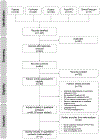Text Message Interventions for Physical Activity: A Systematic Review and Meta-Analysis
- PMID: 31759805
- PMCID: PMC6956854
- DOI: 10.1016/j.amepre.2019.08.014
Text Message Interventions for Physical Activity: A Systematic Review and Meta-Analysis
Abstract
Context: Despite clear health benefits, many individuals fail to achieve the recommended levels of physical activity. Text message interventions to promote physical activity hold promise owing to the ubiquity of cell phones and the low expense of text message delivery.
Evidence acquisition: A systematic review and meta-analysis were performed to examine the impact of text message interventions on physical activity. Searches of PubMed, PsycINFO, Scopus, Cochrane, and ClinicalTrials.gov databases from inception to December 2017 were performed to identify studies investigating one-way text message interventionss to promote physical activity. A subset of RCTs, including an objective (accelerometer-based) physical activity outcome, were included in random-effects meta-analyses in 2018.
Evidence synthesis: The systematic search revealed 944 articles. Of these, 59 were included in the systematic review (12 1-arm trials and 47 controlled trials; n=8,742; mean age, 42.2 years; 56.2% female). In meta-analyses of 13 studies (n=1,346), text message interventionss led to significantly greater objectively measured postintervention steps/day (Cohen's d=0.38, 95% CI=0.19, 0.58, n=10 studies). Analysis of postintervention moderate-to-vigorous physical activity found a similar but not statistically significant effect (Cohen's d=0.31, 95% CI= -0.01, 0.63, n=5 studies). Interventions with more components, tailored content, and interventions in medical populations led to nonsignificantly larger effect sizes compared with text message interventions without these features.
Conclusions: Text message interventions lead to higher objectively measured postintervention physical activity compared with control groups. More extensive, well-controlled studies are needed to examine this relationship further and identify characteristics of effective text message interventions.
Copyright © 2019 American Journal of Preventive Medicine. Published by Elsevier Inc. All rights reserved.
Conflict of interest statement
Dr. Celano has received honoraria from Sunovion Pharmaceuticals for talks on topics unrelated to this work. The authors have no other relevant conflicts of interest to report. No financial disclosures were reported by the authors of this paper.
Figures



Comment in
-
Real-World Considerations for Applicability of Text Message Interventions for Promotion of Physical Activity.Am J Prev Med. 2020 Aug;59(2):e91-e92. doi: 10.1016/j.amepre.2020.02.005. Am J Prev Med. 2020. PMID: 32690205 No abstract available.
-
Response to Letter to the Editor: "Real-World Considerations for Applicability of Text Message Interventions for Promotion of Physical Activity".Am J Prev Med. 2020 Aug;59(2):e93-e94. doi: 10.1016/j.amepre.2020.02.006. Am J Prev Med. 2020. PMID: 32690206 No abstract available.
References
-
- Forouzanfar MH, Afshin A, Alexander LT, et al. Global, regional, and national comparative risk assessment of 79 behavioural, environmental and occupational, and metabolic risks or clusters of risks, 1990–2015: a systematic analysis for the Global Burden of Disease Study 2015. Lancet. 2016;388(10053):1659–1724. 10.1038/sj.bdj.2015.751. - DOI - PMC - PubMed

